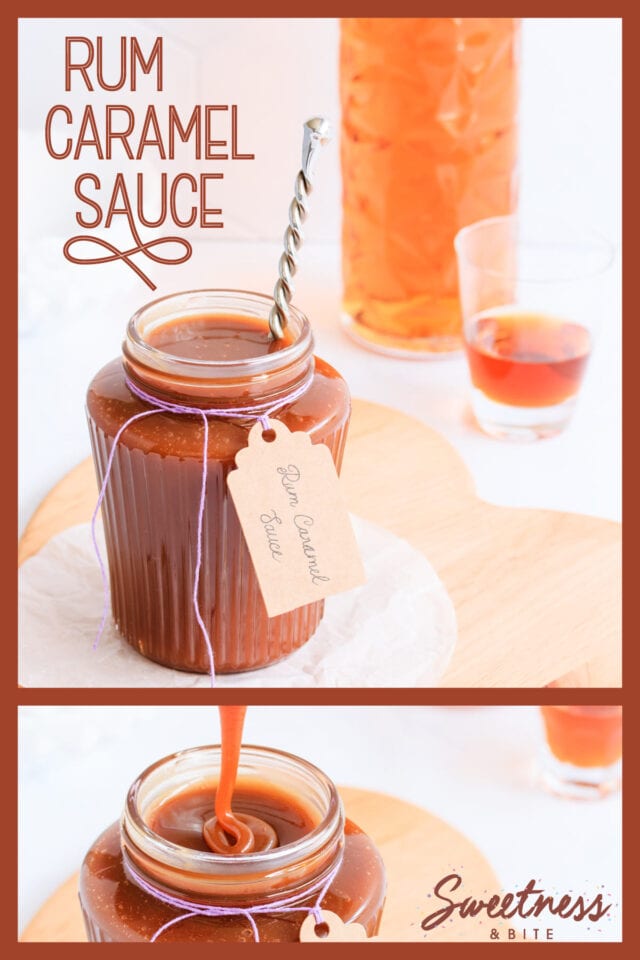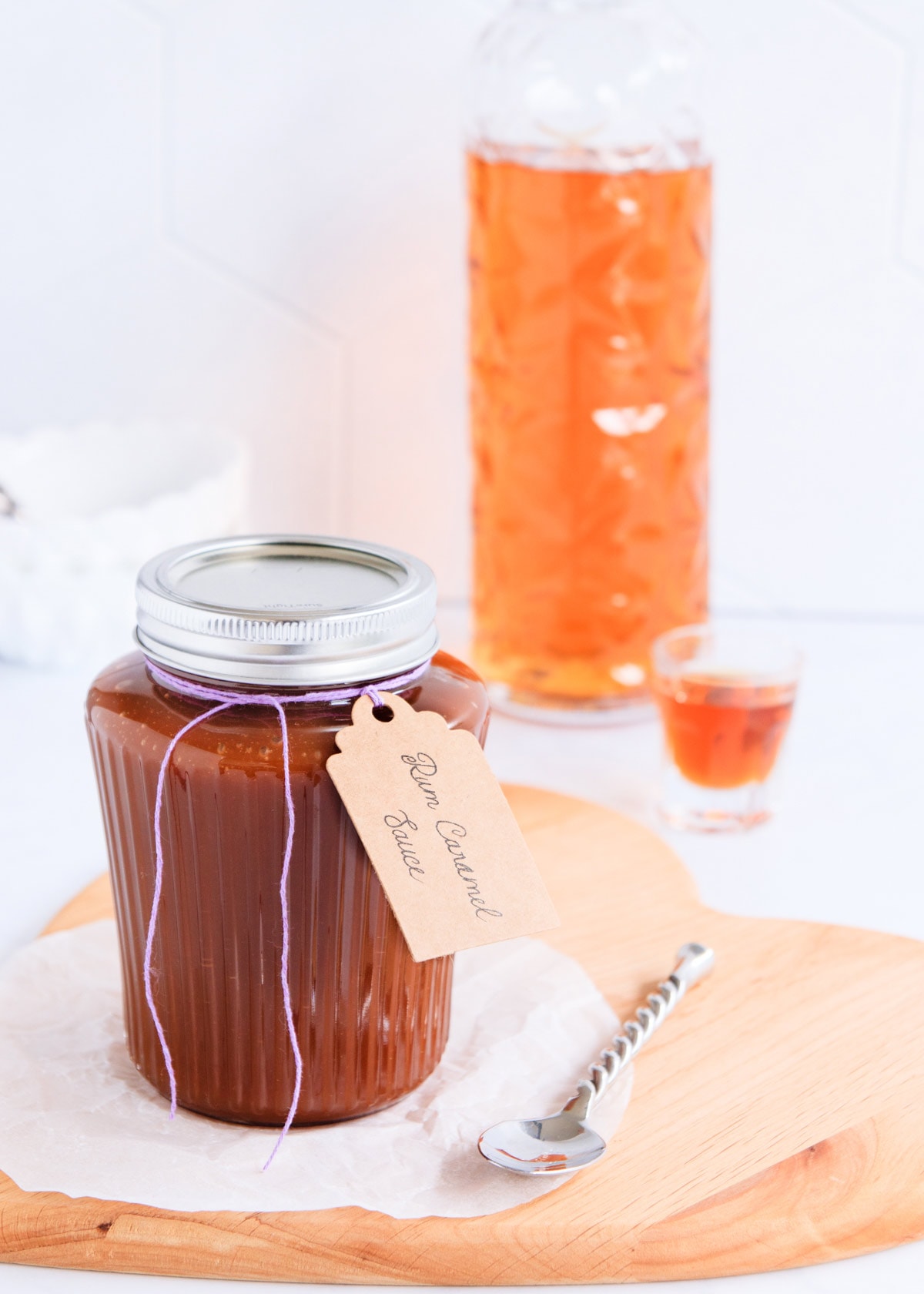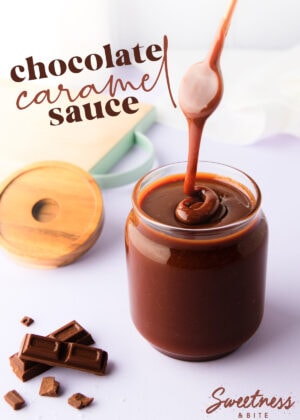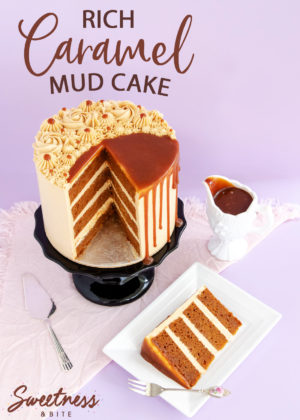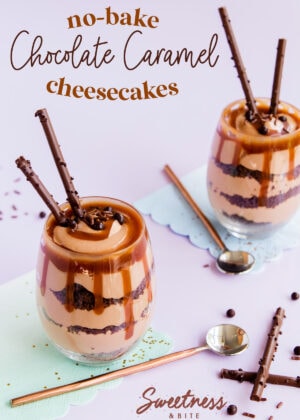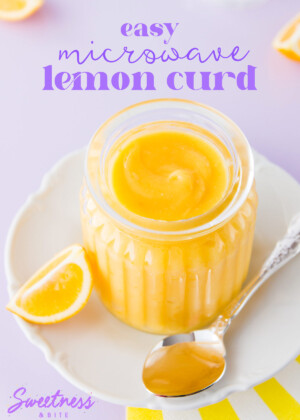Rum Caramel Sauce
This post may contain affiliate links to products I recommend. I receive a small commission at no cost to you if you make a purchase using my link.
If you love caramel, wait until you taste this rum caramel sauce! Thick creamy caramel with a hit of smooth rum, you’ll want to drizzle it all over everything.
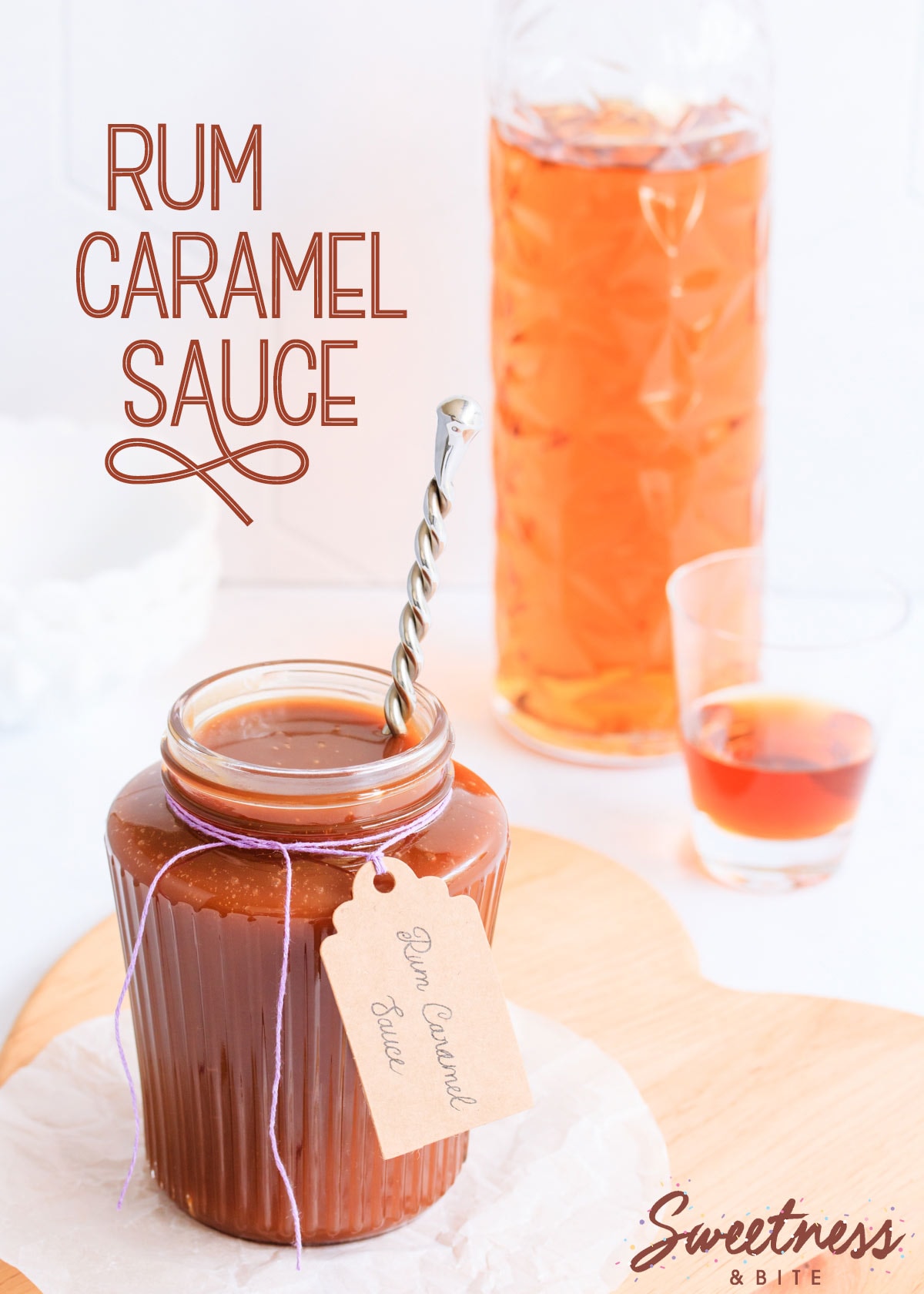
Rum and caramel sauce is a match made in heaven. Rum already has those notes of caramel in its flavour, it’s made from sugar cane, after all, and adding it to caramel sauce makes for an even-richer-than-caramel caramel flavour.
I know, you might be thinking, isn’t this a bit, well, extra? But hey, when did extra become a bad thing? Why shouldn’t you take a great thing and make it even better?!
Because regular homemade caramel sauce is great, but if you’re in the mood to be a little extra, then you should definitely add a little rum to it!
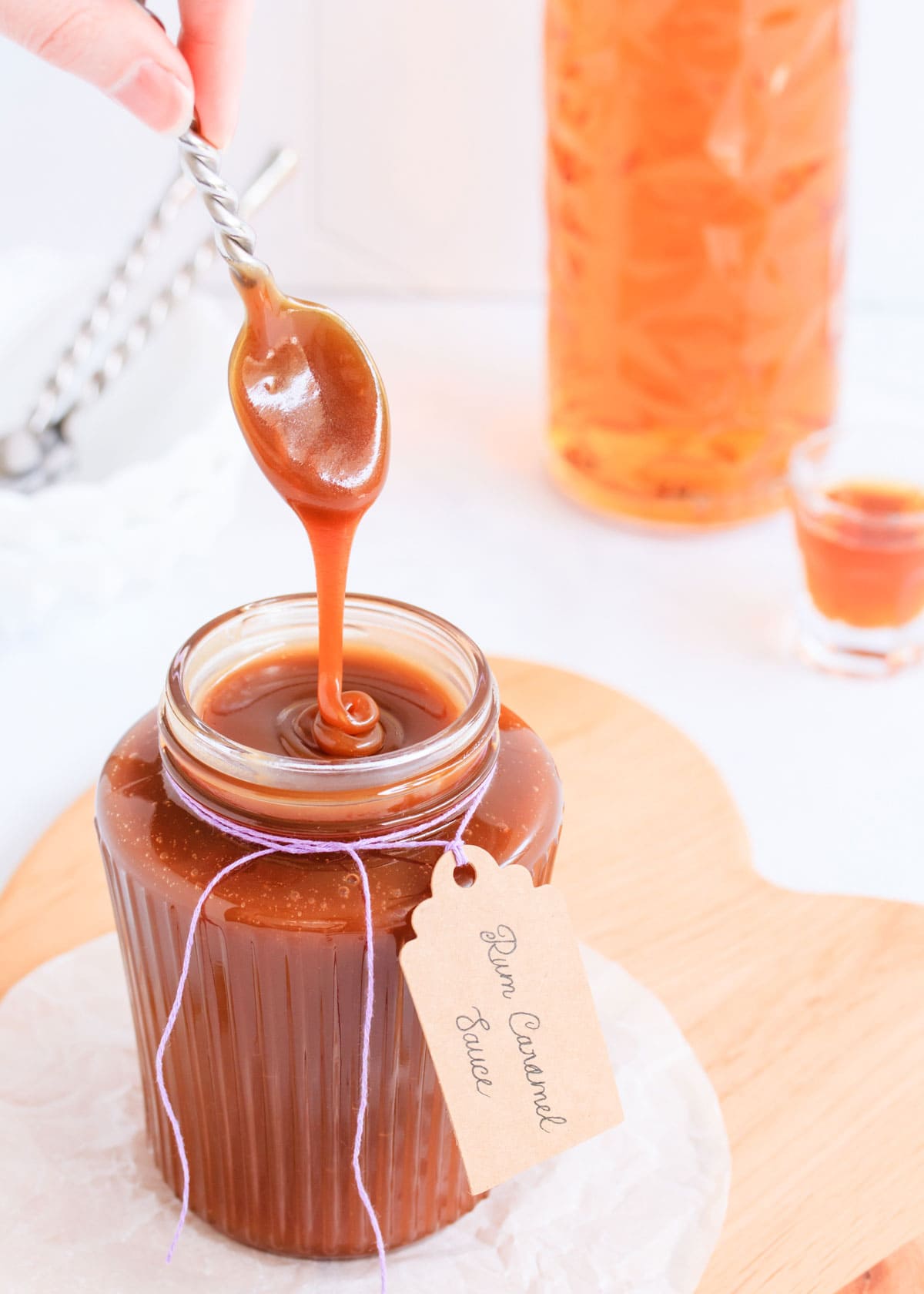
Rum caramel Sauce Ingredients
Good news! You only need seven simple ingredients to make this, and one of them is water so it barely even counts.
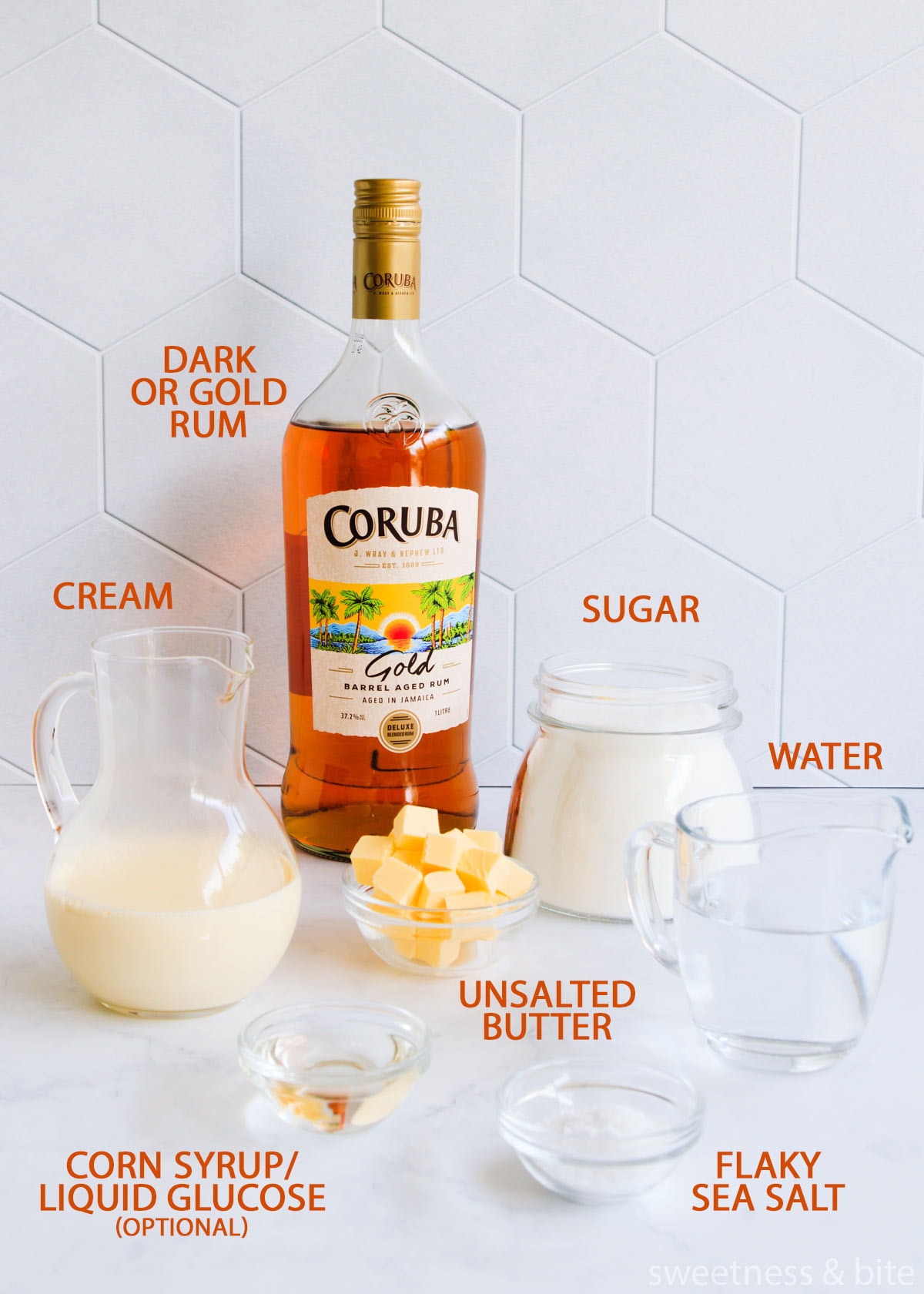
Sugar – I like to use caster (superfine) sugar to make caramel as it dissolves more quickly, but use regular granulated sugar if that’s what you have.
Corn syrup or liquid glucose – This is optional, but I recommend using it, especially if you’re new to making caramel. It helps stop the sugar recrystallising and making the caramel sauce grainy.
Cream – The cream you need for this recipe is known by different names in different countries. Here in NZ it’s usually called standard cream or whipping cream. Elsewhere it may also be known as single cream or full cream. Heavy cream will also work and will give you a slightly thicker sauce.
Unsalted butter – Using unsalted butter makes it easier to control the amount of salt added to the sauce. If you only have salted butter, taste your sauce before adding the sea salt, then add small amounts of salt at a time, until the desired saltiness is achieved.
Flaky sea salt – I use sea salt that has quite fine flakes. If using coarser salt such as kosher salt, you may need to grind it up a bit to make sure it dissolves properly. Only have regular table salt? You will need to use much less, as it is finer than flaky salt.
Rum – The star of the show! I used a gold rum because that’s what we had on hand, but either dark rum or gold rum will work here. I probably wouldn’t use white rum as the flavour tends not to be as smooth. But hey if that’s what you’ve got then by all means give it a go. And if you don’t want to use rum, you could use whiskey instead.
As an optional extra, you can add a teaspoon of vanilla extract, vanilla paste or the seeds from a vanilla bean. My homemade vanilla extract contains rum, so it’s really the perfect addition.
To make a spiced rum caramel sauce:
You can add a few pinches of your favourite spices. You could use cinnamon and/or ginger, maybe a little cardamom. Pumpkin pie spice would also be nice, or mixed spice if you’re in NZ.
Equipment
- Medium saucepan – a heavy-based pan is best as it heats more evenly.
- Long handled spoon or spatula
- Pastry brush
- Candy thermometer – optional, don’t worry if you don’t have one.
- Heatproof trivet or board – to put the pan on when you take it off the heat. It will be very hot.
Before you start, make sure you have all of your ingredients measured and ready to go, plus all of your equipment ready. Caramel is all about timing, and you’re less likely to burn it if you have everything you need easily at hand.
How to Make Rum Caramel sauce
If this is your first time making caramel, then I want to start off by saying, I know it can seem daunting, but don’t stress about it. It’s a simple recipe as long as you follow the instructions carefully and keep your wits about you.
I make this using the “wet caramel” method, which just means we’re adding water to the sugar to help it dissolve. I think this method is easier for beginners, but if you are confident making caramel and prefer the dry method you can go ahead and do that. Catch us up once the caramel is cooked.
Start by warming up the cream slightly – this makes it easier to combine with the caramel later. Just heat it in the microwave for 30-40 seconds, or until warm.
Place your sugar, corn syrup and water in a medium sized, heavy-based saucepan. Use one a little bigger than you think you’ll need, as the caramel will bubble up.
At this stage, you can give it a gentle stir to combine everything, and start heating it over medium-high heat. Give it a little stir every now and then as it comes to a boil, to help the sugar dissolve.
Once it comes to a boil, stop stirring. Don’t worry if the sugar isn’t all dissolved, it soon will be. Brush down the sides of the pan using a pastry brush dipped in water. You want to remove any sugar crystals you can see, as they can make your caramel grainy later.
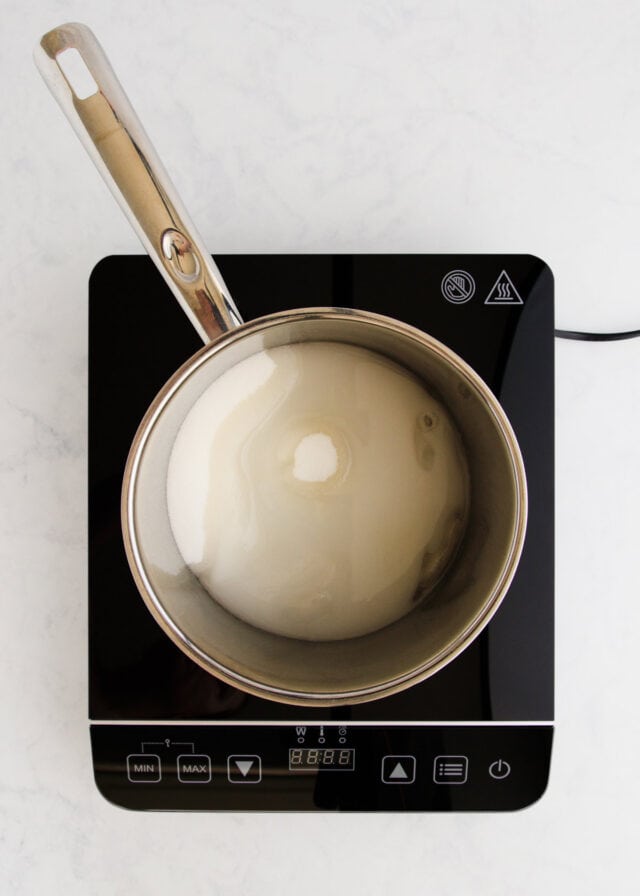
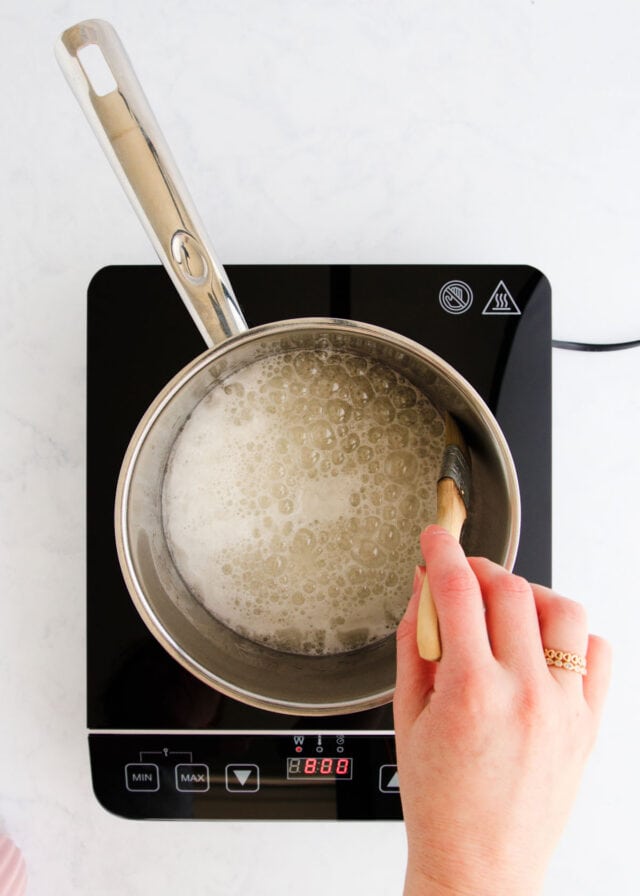
You can clip on a candy thermometer if you have one, but if not, don’t worry, we can do this all by eye (and nose).
The syrup will boil with quite thin bubbles that rise to the top and pop quickly. As it continues to cook and starts to turn golden, the bubbles will start to get thicker and pop more slowly. You’ll also start to really smell it now.
Remember, don’t stir the caramel! However, you can swirl the pan a couple of times as it cooks, to allow it to colour evenly.
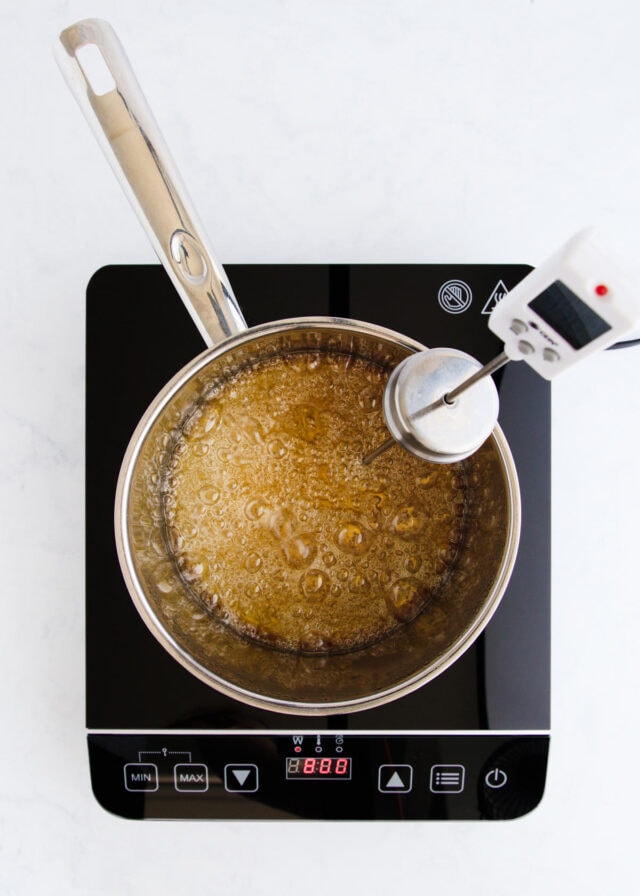
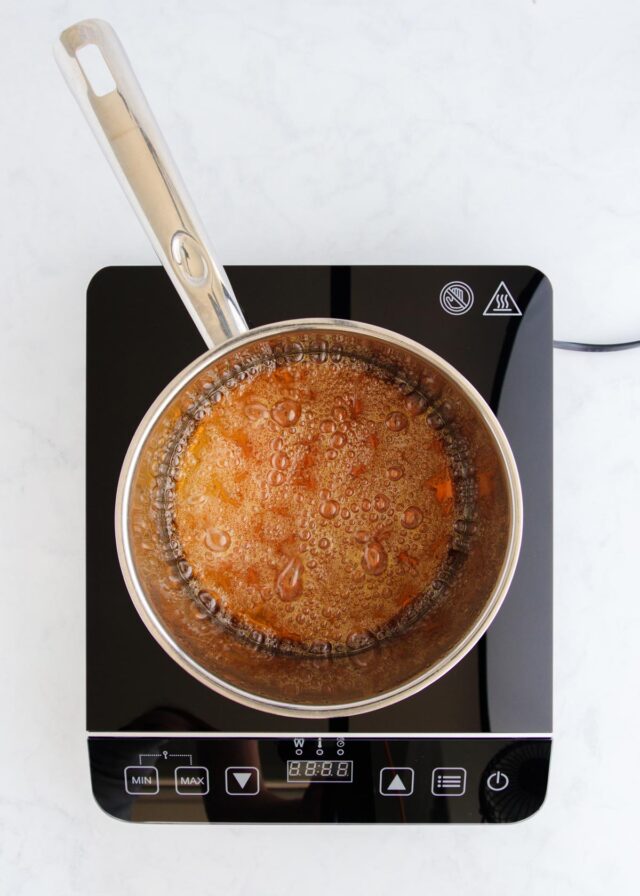
If you’re using a candy thermometer, the caramel will be around 170°C (340°F). If you’re not using a thermometer, you want to cook it until it’s an even, amber colour and smells delightful. Make sure you keep a close eye on it, as it can go from golden to burnt very quickly.
Once it’s ready, remove it from the heat and immediately add in the cream you warmed up earlier. Gradually pour it in while you stir with a long-handled spoon or spatula. Be careful, it will splutter a bit.
Boil the caramel again over medium-high heat for 1-2 more minutes, or until it reaches 115°C (240°F).
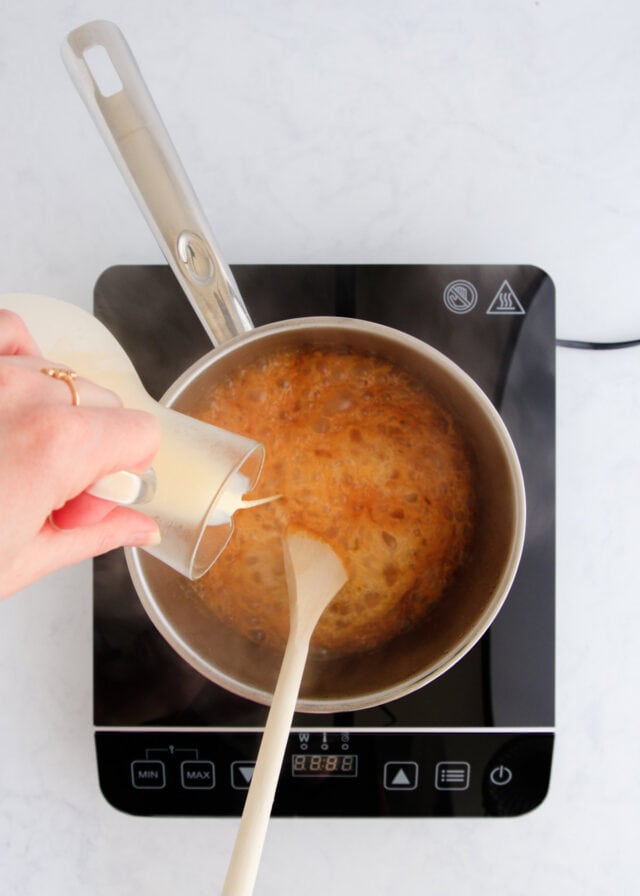
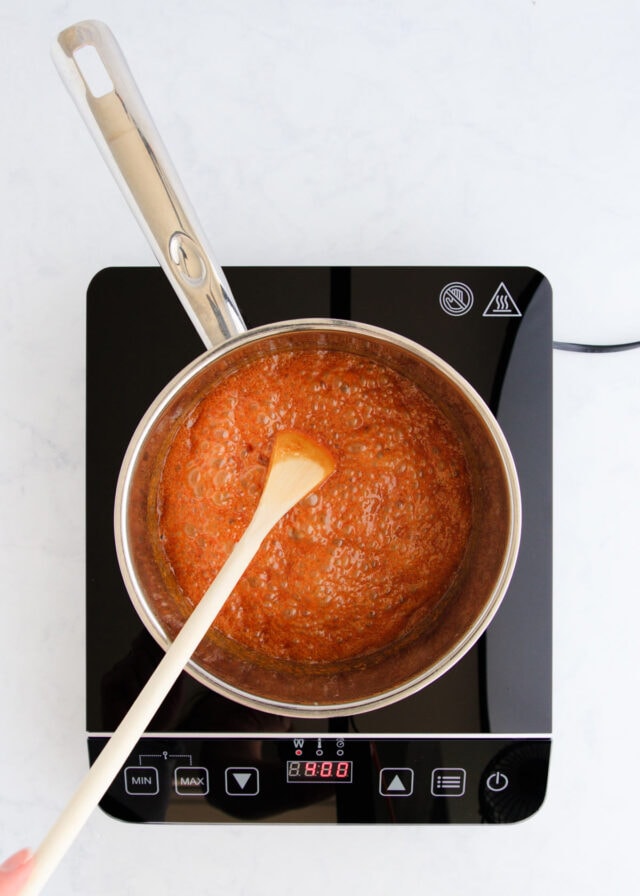
Then you’ll turn off the heat and add in the salt and butter.
Salt in caramel is great, but not everyone likes it super salty. Start by adding 1/2 – 3/4 of the salt, then allow a spoonful of the sauce to cool slightly (it’s hot as hell!), taste it and add more salt if needed.
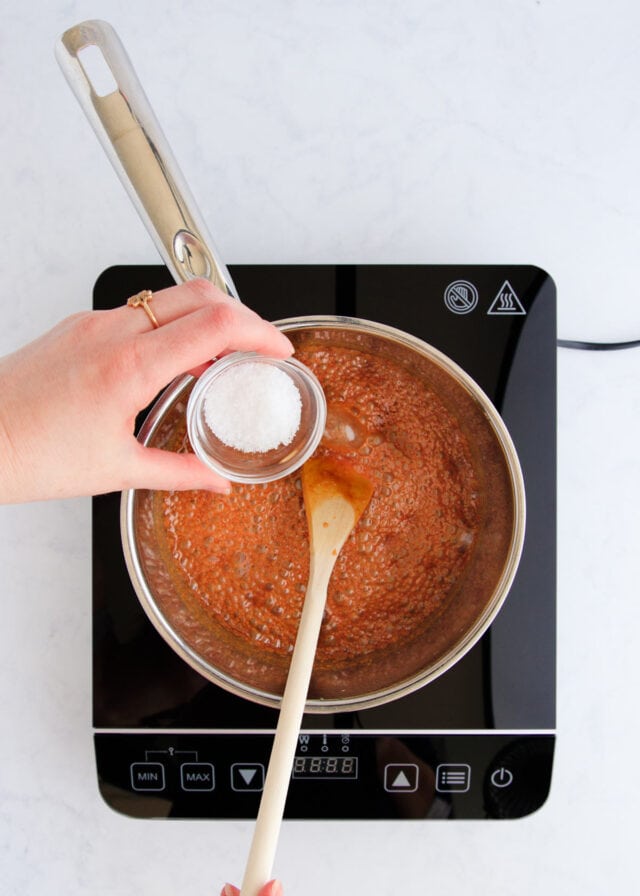
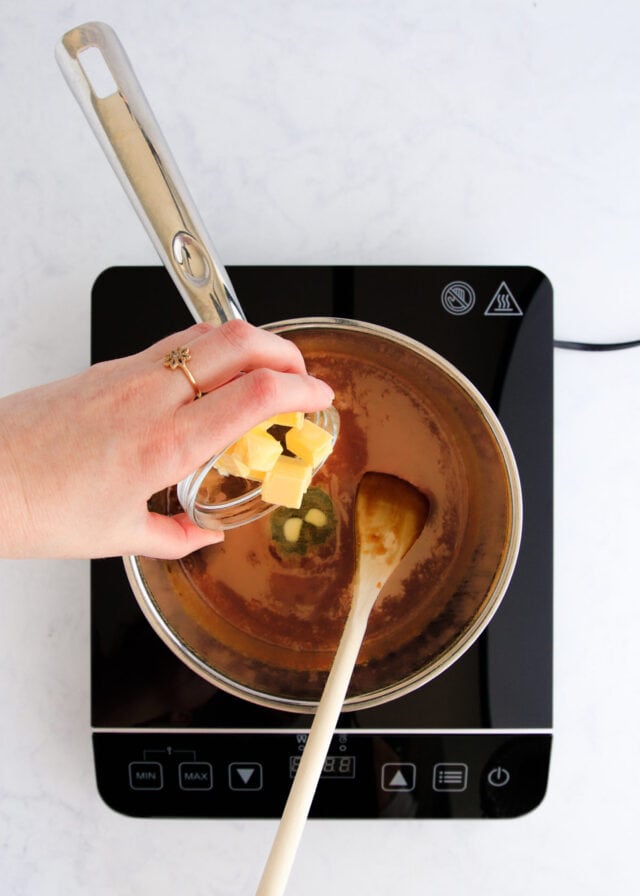
Then all that’s left to do is add the rum! You can start with half the amount and then add more if you want, or slosh it all in like I do. You do you.
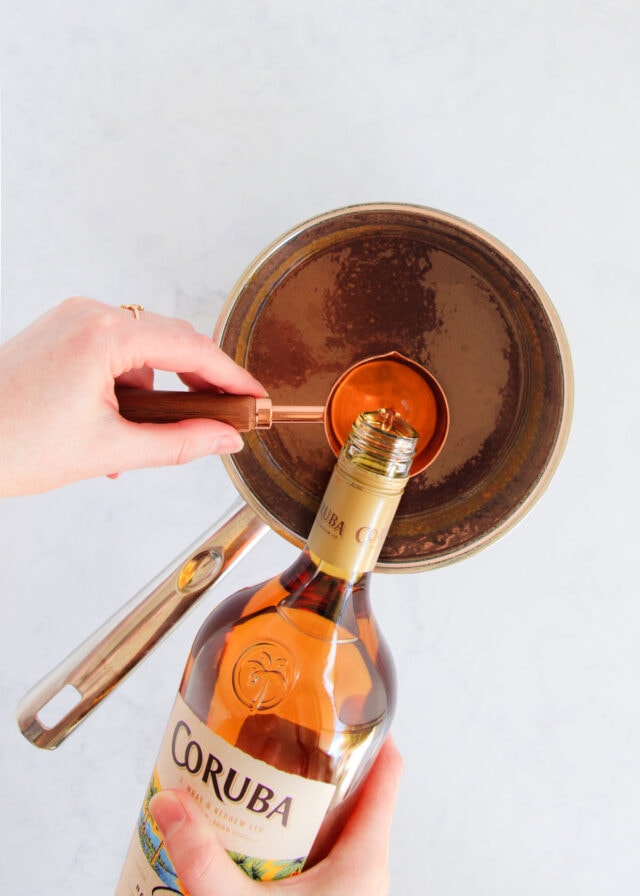
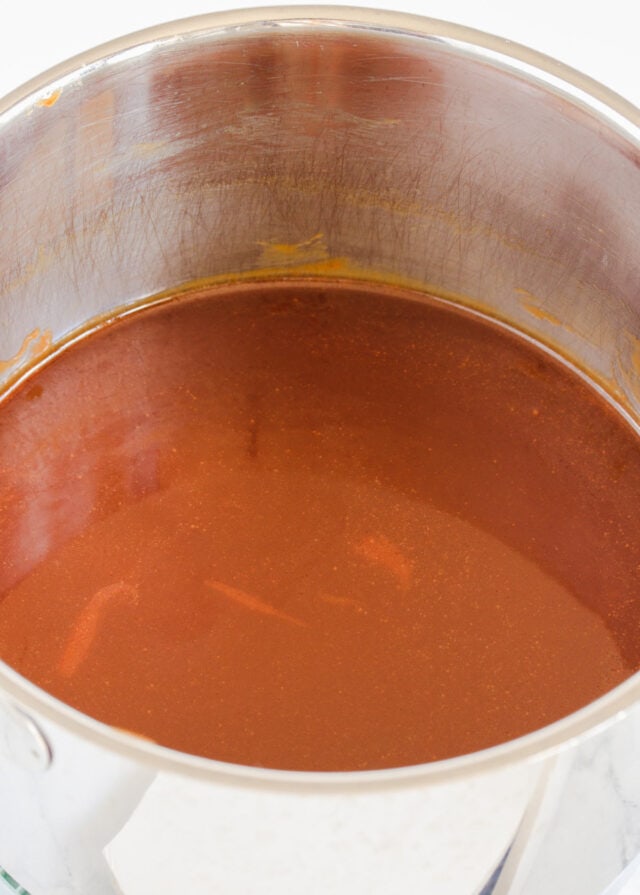
Allow the sauce to cool a little before pouring it into a heatproof jar or container. The sauce will continue to thicken as it cools.
Storing the Sauce
When stored in an airtight container or lidded jar, the caramel sauce will last for at least several months in the refrigerator. If you don’t eat it all in one go, that is.
You can reheat the sauce gently in the microwave or in a small saucepan on the stove before use.
Quick Q&A
In the most basic terms, caramel crystallises (or turns “grainy”) when undissolved sugar crystals attract dissolved sucrose in the caramel and cause it to recrystallise. Adding glucose (in the form of liquid glucose/corn syrup) helps prevent the sucrose from being able to recrystallise.
No. It is helpful, but you definitely don’t need a candy thermometer to make caramel. All you really need are your eyes and your nose. When the caramel is a rich golden colour, and it smells delicious, the caramel is ready for you to add the cream.
Heat your cream up slightly before you add it to the caramel – it will create less steam than cold cream does when it hits the hot caramel. I just warm it up in the microwave for 30-40 seconds, but you could do it in a small pan on the stove.
You can use dark rum or gold rum in this recipe. White rum is typically too light in flavour.
Because of the rum, this sauce isn’t *quite* as thick as my plain caramel sauce, so I don’t think I would recommend it for caramel drip cakes. If you do want to use it as a drip, I’d suggest reducing the amount of cream by 1/4 cup, to make the sauce a bit thicker.
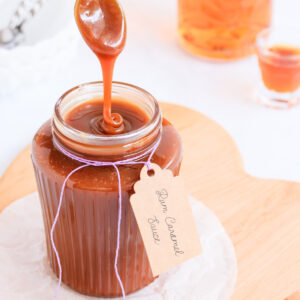
Rum Caramel Sauce
Ingredients
- ¾ cup cream (180ml)
- 2 cups sugar (400g) caster or superfine sugar works best
- ½ cup water (125ml)
- 2 tablespoons corn syrup or liquid glucose (40g) optional
- 2 tablespoons unsalted butter (approx. 25 grams)
- 1 teaspoon flaky sea salt
- ¼ cup rum – dark or gold (60ml)
Instructions
- Before you start, make sure you have all of your ingredients measured and ready to go, plus all of your equipment ready. Caramel is all about timing, and you're less likely to burn it if you have everything you need easily at hand ❤
- Measure the cream into a microwave-safe jug, and heat until warm (around 30 seconds, depending on your microwave power). The temperature isn’t too important, but warming the cream slightly will help it splatter less when you add it to the caramel. Set aside.
- Combine the sugar, water and corn syrup or glucose in a medium saucepan, stirring gently until all the sugar is moistened.
- Place over medium-low heat and stir for a minute or so, without letting it boil, until the sugar starts to dissolve. Use a pastry brush dipped in water to brush down any remaining sugar crystals on the sides of the pan.
- Increase the heat to high and bring the syrup to a boil, and boil until it reaches a deep amber colour. It will be about 170°C (338°F) on a sugar thermometer. You can swirl the pan gently to colour the caramel evenly.If you don’t have a thermometer, pay attention to the stages the syrup goes through. After it comes to a boil, the last of the sugar crystals will dissolve. The bubbles will be thin and rise and pop quickly on the surface. As the syrup cooks and the water evaporates, the bubbles will become thicker and a little slower to pop. Once it reaches the deep amber colour, it’s ready.
- Immediately remove the caramel from the heat, and carefully pour in the cream. It will splatter, so be careful! Stir with a wooden spoon or heatproof spatula to combine. Don’t panic if there are any hard bits of set caramel.
- Place the pan back over medium heat, and bring it back to a boil, stirring constantly, until the sauce reaches 115°C (240°F).If not using a thermometer, just boil the sauce for a couple of minutes, until it darkens a little more in colour and thickens slightly.
- Remove from the heat and whisk in the butter until combined.Add the rum and most of the salt. Once it’s all combined, remove a spoonful of the sauce, let it cool a bit and taste it to check the salt level. Add more salt if necessary.
- Leave the sauce to cool before using. It will thicken as it cools.
- Store the sauce in a sealed container in the refrigerator for several weeks. Reheat gently before using.
Notes
Nutritional Disclaimer: Any nutritional info provided is a computer generated estimate and is intended as a guide only.

